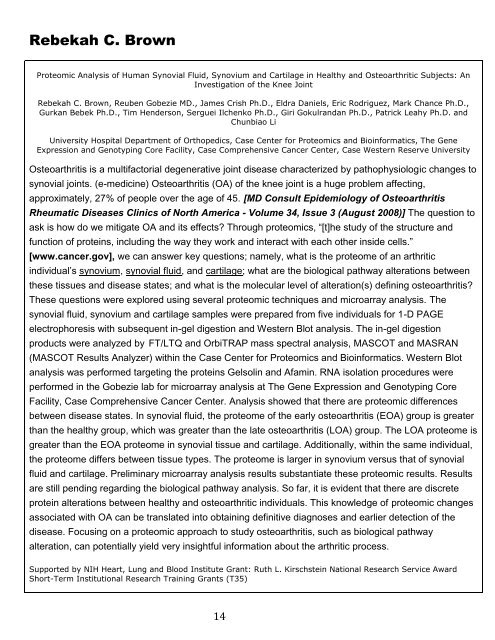student research day - Case Western Reserve University School of ...
student research day - Case Western Reserve University School of ...
student research day - Case Western Reserve University School of ...
You also want an ePaper? Increase the reach of your titles
YUMPU automatically turns print PDFs into web optimized ePapers that Google loves.
Rebekah C. Brown<br />
Proteomic Analysis <strong>of</strong> Human Synovial Fluid, Synovium and Cartilage in Healthy and Osteoarthritic Subjects: An<br />
Investigation <strong>of</strong> the Knee Joint<br />
Rebekah C. Brown, Reuben Gobezie MD., James Crish Ph.D., Eldra Daniels, Eric Rodriguez, Mark Chance Ph.D.,<br />
Gurkan Bebek Ph.D., Tim Henderson, Serguei Ilchenko Ph.D., Giri Gokulrandan Ph.D., Patrick Leahy Ph.D. and<br />
Chunbiao Li<br />
<strong>University</strong> Hospital Department <strong>of</strong> Orthopedics, <strong>Case</strong> Center for Proteomics and Bioinformatics, The Gene<br />
Expression and Genotyping Core Facility, <strong>Case</strong> Comprehensive Cancer Center, <strong>Case</strong> <strong>Western</strong> <strong>Reserve</strong> <strong>University</strong><br />
Osteoarthritis is a multifactorial degenerative joint disease characterized by pathophysiologic changes to<br />
synovial joints. (e-medicine) Osteoarthritis (OA) <strong>of</strong> the knee joint is a huge problem affecting,<br />
approximately, 27% <strong>of</strong> people over the age <strong>of</strong> 45. [MD Consult Epidemiology <strong>of</strong> Osteoarthritis<br />
Rheumatic Diseases Clinics <strong>of</strong> North America - Volume 34, Issue 3 (August 2008)] The question to<br />
ask is how do we mitigate OA and its effects? Through proteomics, “[t]he study <strong>of</strong> the structure and<br />
function <strong>of</strong> proteins, including the way they work and interact with each other inside cells.”<br />
[www.cancer.gov], we can answer key questions; namely, what is the proteome <strong>of</strong> an arthritic<br />
individual’s synovium, synovial fluid, and cartilage; what are the biological pathway alterations between<br />
these tissues and disease states; and what is the molecular level <strong>of</strong> alteration(s) defining osteoarthritis?<br />
These questions were explored using several proteomic techniques and microarray analysis. The<br />
synovial fluid, synovium and cartilage samples were prepared from five individuals for 1-D PAGE<br />
electrophoresis with subsequent in-gel digestion and <strong>Western</strong> Blot analysis. The in-gel digestion<br />
products were analyzed by FT/LTQ and OrbiTRAP mass spectral analysis, MASCOT and MASRAN<br />
(MASCOT Results Analyzer) within the <strong>Case</strong> Center for Proteomics and Bioinformatics. <strong>Western</strong> Blot<br />
analysis was performed targeting the proteins Gelsolin and Afamin. RNA isolation procedures were<br />
performed in the Gobezie lab for microarray analysis at The Gene Expression and Genotyping Core<br />
Facility, <strong>Case</strong> Comprehensive Cancer Center. Analysis showed that there are proteomic differences<br />
between disease states. In synovial fluid, the proteome <strong>of</strong> the early osteoarthritis (EOA) group is greater<br />
than the healthy group, which was greater than the late osteoarthritis (LOA) group. The LOA proteome is<br />
greater than the EOA proteome in synovial tissue and cartilage. Additionally, within the same individual,<br />
the proteome differs between tissue types. The proteome is larger in synovium versus that <strong>of</strong> synovial<br />
fluid and cartilage. Preliminary microarray analysis results substantiate these proteomic results. Results<br />
are still pending regarding the biological pathway analysis. So far, it is evident that there are discrete<br />
protein alterations between healthy and osteoarthritic individuals. This knowledge <strong>of</strong> proteomic changes<br />
associated with OA can be translated into obtaining definitive diagnoses and earlier detection <strong>of</strong> the<br />
disease. Focusing on a proteomic approach to study osteoarthritis, such as biological pathway<br />
alteration, can potentially yield very insightful information about the arthritic process.<br />
Supported by NIH Heart, Lung and Blood Institute Grant: Ruth L. Kirschstein National Research Service Award<br />
Short-Term Institutional Research Training Grants (T35)<br />
14
















